- Remittance
- Exchange Rate
- Stock
- Events
- EasyCard
- More
- Download
Still Can’t Master Low-Cost Investing? Lazy Guide to ETFs: A One-Article Lesson on How to Choose the
Are you losing sleep over stock-picking worries? Are you constantly glued to a single stock? Are you anxious about market fluctuations and can’t find peace?
If you’re like me, sometimes you see hundreds or even thousands of stocks in the market and don’t know where to start. But what if you don’t have the time or energy to invest? Don’t worry, today I’m going to share with you a lazy investment strategy—ETFs. Not only can ETFs save you time and effort, but they can also help you easily navigate the U.S. stock market!
First, let’s quickly understand what ETFs are.
An ETF, or Exchange-Traded Fund, is a type of fund that can be traded on an exchange. As the name suggests, it’s essentially a fund that allows you to invest in a basket of assets like stocks, bonds, commodities, and more.
Unlike traditional funds, ETF prices fluctuate in real-time and can be traded like stocks during market hours on an exchange. This makes them both flexible and transparent. However, because of this characteristic, ETFs might have more price volatility compared to mutual funds.
We don’t need to spend a lot of time and effort analyzing and selecting individual stocks; we just need to choose an ETF that suits our investment goals.
Moreover, ETF trading costs are usually low, and there are no minimum investment requirements.
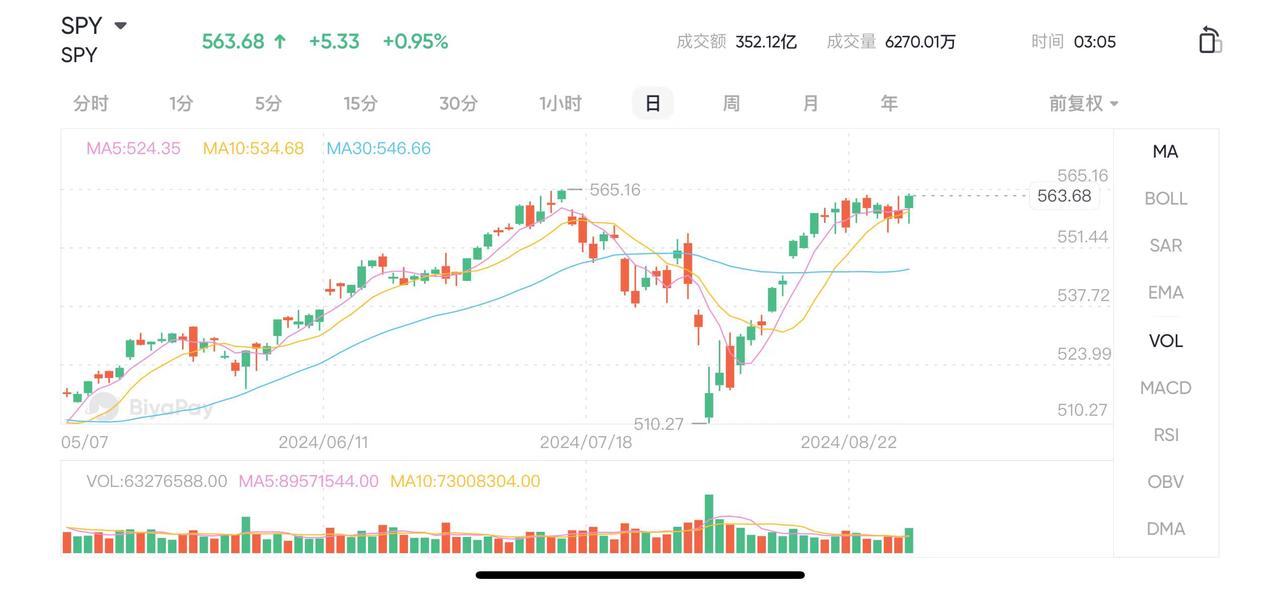
We can invest in a basket of assets more conveniently and at a lower cost through ETFs, but in practice, you may notice that the performance of an ETF doesn’t always perfectly match that of the underlying index. For example, if we observe the S&P 500 index and an S&P 500 ETF simultaneously, we’ll sometimes find that the ETF’s performance slightly lags behind the index. Why is this? I’m sure some of you have the same question as I do.
This is because any ETF will have what is known as tracking error. The larger the tracking error, the further the ETF’s performance deviates from the underlying index or asset. There are many reasons for tracking errors, including trading rules, ETF fees, and leverage. In most cases, ETFs with higher fees may also have higher tracking errors.
What types of ETFs are there?
ETFs come in many varieties and can be categorized by asset class into equity ETFs, bond ETFs, commodity ETFs, and more.
By fund attributes, they can be divided into passive ETFs and active ETFs:
- Passive ETFs aim to track the performance of a specific index. You can think of investing in a passive ETF as equivalent to investing in the index it tracks. The indices tracked by passive ETFs vary, ranging from market or sector indices to bond or commodity indices.
- Active ETFs aim to outperform the market or their benchmark index and achieve higher returns. Compared to passive ETFs, fund managers of active ETFs usually manage the portfolio more actively. Typically, active ETFs carry higher potential risks and rewards than passive ETFs, but they also tend to have higher management fees.
There’s also a special type of ETF—leveraged ETFs, which amplify returns through the use of leverage. However, it’s important to note that leveraged ETFs are not suitable for long-term holding because their rebalancing mechanism can magnify losses in a volatile market.

As a stock market beginner, how do you choose the right ETF, and how do you buy it?
Why ETFs? Why are ETFs considered a savior for beginners?
This brings us to the advantages of ETFs:
- Risk Diversification: ETFs typically track different indices, sectors, or asset classes, inherently providing risk diversification. This means investors can reduce the risk associated with individual stocks by purchasing a basket of stocks.
- Flexible Trading: ETFs can be freely bought and sold in the secondary market like stocks, with prices fluctuating in real-time. This allows investors to quickly adjust their portfolios based on market conditions.
- Low Cost: Passive ETFs have lower trading costs because they don’t require frequent adjustments like active ETFs and don’t need intervention by fund managers, thereby saving on management fees.
- Low Barrier to Entry: Most ETFs have a per-share price between 0.5 to 5 yuan, so you can start investing with just a few hundred yuan, making it very beginner-friendly.
- Easy to Understand and Operate: ETFs combine the advantages of stocks, open-end index funds, and closed-end funds, making them an efficient tool for index investing. They are suitable for both dollar-cost averaging and lump-sum investments, making them ideal for novice investors.
- Significant Long-Term Returns: Many experts and successful investors recommend ETFs as a tool for long-term investing because they offer stable returns and are relatively easy to manage.
Like me, you might have been obsessed with finding specific ten-bagger stocks, watching several stocks closely every day. But then I realized that this approach involves too many uncertainties for me…
I had to start by understanding each company, and there are many key indicators I wasn’t familiar with. The cost of my effort was already quite high, and I still couldn’t put all my eggs in one basket! In other words, I needed to achieve diversified investing!
By now, you’re probably thinking the same thing I was: Is there a way to bundle together several companies I like?
Actually, those three letters—ETF—seem like they were tailor-made for beginners! Not only can they help you easily achieve diversified investments, but they also save you the trouble of picking individual stocks. Imagine, by just buying one ETF, you’re essentially owning a basket of stocks at once. Isn’t that cool!?
So the question is, with so many ETFs available, how does a beginner choose the right one?
- Clarify Your Investment Goals First, ask yourself: Do you want to make money steadily, or are you willing to take risks for higher returns? This step is crucial. It determines what type of ETF you should choose.
- Research the Tracking Index Each ETF has an index it tracks, and understanding these indices is as important as knowing your investment partners.
- Pay Attention to Costs Low cost is an advantage of ETFs, and choosing a low-fee ETF can maximize your benefits.
- Understand the Holdings Check what’s inside the ETF and make sure it aligns with your investment philosophy.
Key indicators to evaluate an ETF’s tracking performance include the following:
- Tracking Difference refers to the deviation between the ETF’s return and the return of the underlying index. The daily tracking difference equals the ETF’s daily net asset value growth rate minus the daily return of the underlying index. This indicator reflects the short-term performance variations of the ETF relative to its underlying index.
- Tracking Error is a crucial indicator for measuring how well an ETF tracks the performance of its underlying index, reflecting the degree of fit between the fund and the index. Tracking error equals the standard deviation of the tracking differences over the observation period. If the tracking error is small, it indicates that the ETF closely follows the underlying index in both the short and long term; conversely, if the tracking error is large, it suggests a significant deviation between the ETF’s performance and the underlying index.
In addition to these, other factors can also impact an ETF’s performance, although they are not primary evaluation criteria:
- Liquidity: The liquidity of an ETF affects the ease and cost of trading for investors. While larger ETFs generally have better liquidity, this doesn’t necessarily mean that all large ETFs have the best liquidity.
- Fees: The management fees and other related expenses of an ETF are also important factors to consider when selecting an ETF, as these fees directly impact the final investment return.
How to choose the right ETF based on personal risk preferences?
- Understand Your Risk Preference: First, investors need to clarify their risk tolerance. Generally, ETFs are categorized into five types based on the asset class: equity, cross-border, gold, bond, and money market ETFs. Different types of ETFs have different risk levels and return characteristics. For example, equity ETFs and cross-border ETFs carry higher risks, while bond ETFs and money market ETFs are relatively lower risk.
- Choose the Appropriate ETF Type: Based on your risk preference, choose the corresponding type of ETF. High-risk investors can choose commodity ETFs or ETFs related to the U.S. stock market (e.g., Nasdaq ETFs, S&P 500 ETFs); medium-risk investors can choose A-share market thematic ETFs, sector ETFs, or broad-based index ETFs; low-risk investors can opt for bond ETFs or money market ETFs.
- Evaluate Fees: After selecting the appropriate ETF type, the next step is to focus on the fees of that ETF. Generally, ETF management fees are relatively low, cheaper than the 1.5% fees of active funds and the 1% fees of tiered index funds. Therefore, when choosing ETFs, try to select those with lower fees to reduce long-term investment costs.
- Consider Other Factors: Besides fees, other factors such as the fund’s historical performance, liquidity, and tracking error should also be considered. These factors can influence the final investment outcome and returns.
How can beginners build a suitable ETF investment portfolio?
You can start by trying a balanced portfolio recipe: 60% Core ETF + 20% Stable Dividend ETF + 20% Growth ETF
This recipe is like a delicious investment meal: Core ETFs are the main course, providing you with stable energy; stable dividend ETFs are the vegetables, offering necessary nutrients; growth ETFs are the tasty dessert, bringing more excitement to your taste buds!
Don’t worry about where to start; here are some recommended ETF types for beginners:
- Large-Cap Index ETFs: Such as SPY (tracking the S&P 500 index), giving you a panoramic view of the U.S. stock market.
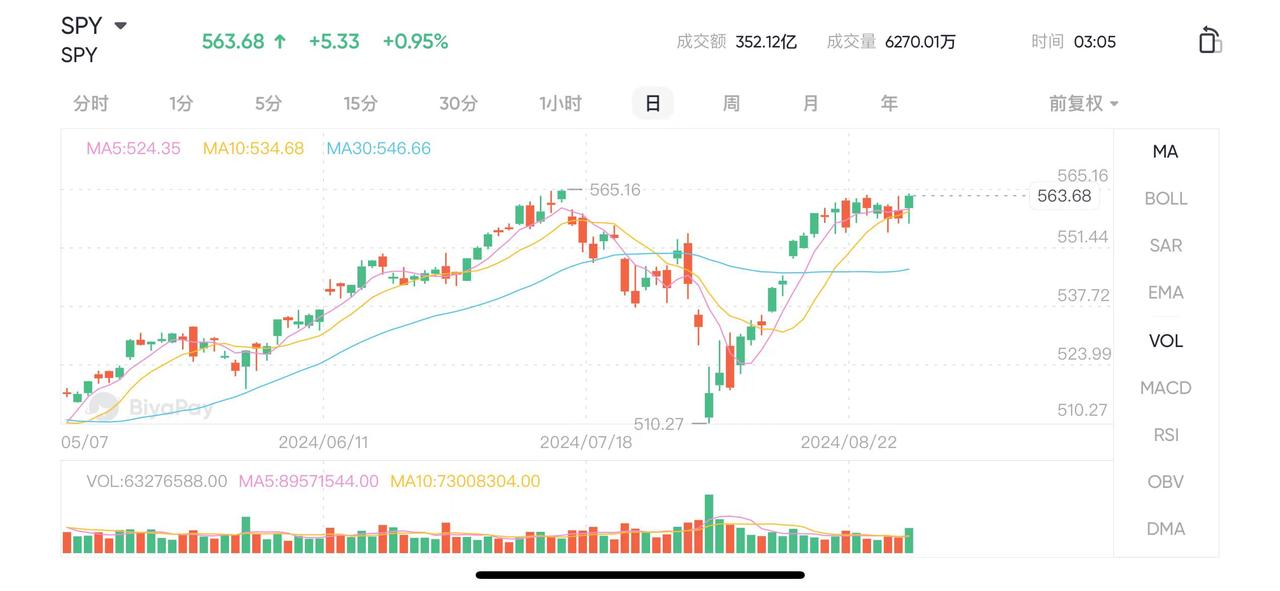
- Technology Sector ETFs: Like QQQ (tracking the Nasdaq 100 index), allowing you to catch the fast train of technological innovation.
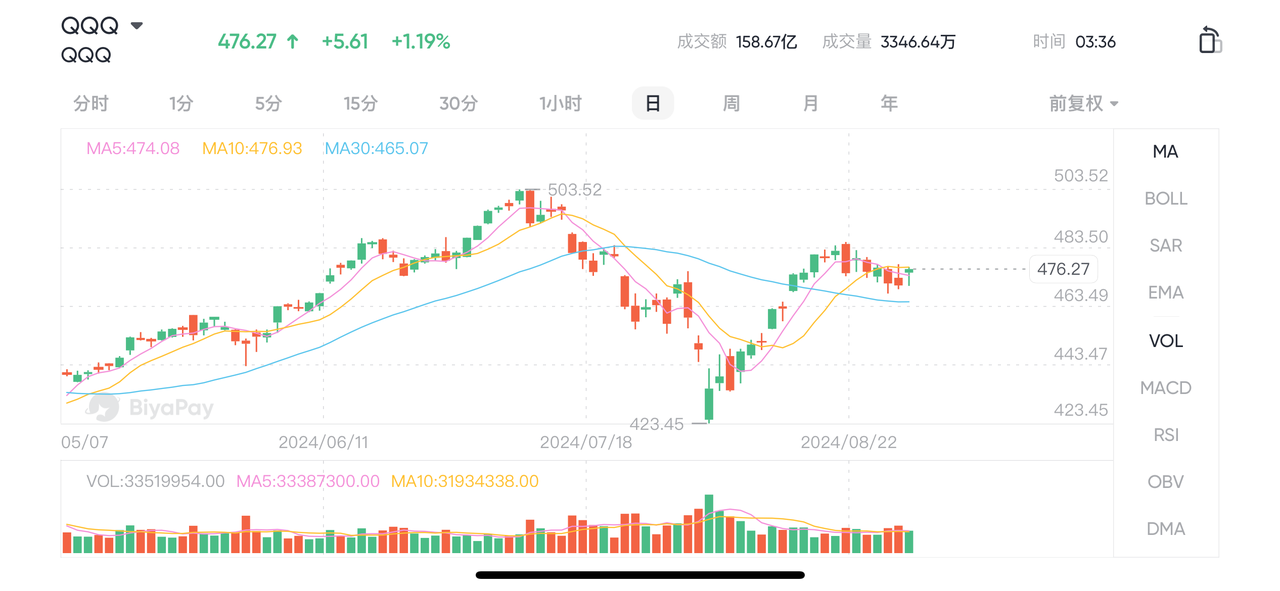
- Dividend ETFs: Suitable for investors who prefer steady and reliable investments.
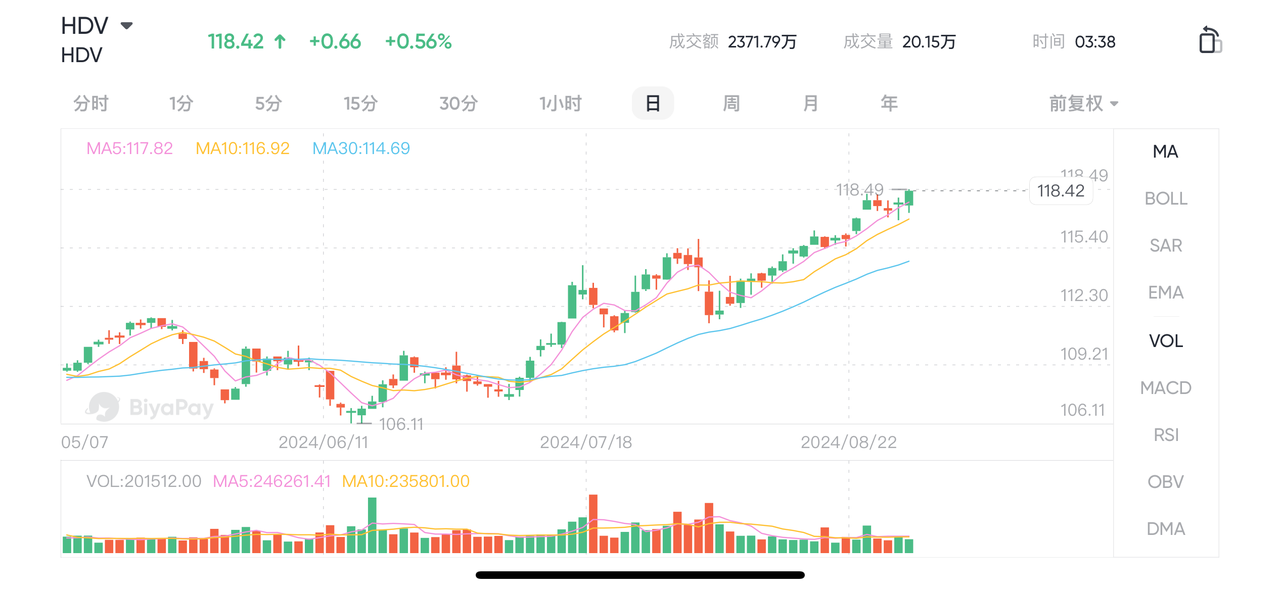
- Bond ETFs: Adding a layer of stability to your investment portfolio.
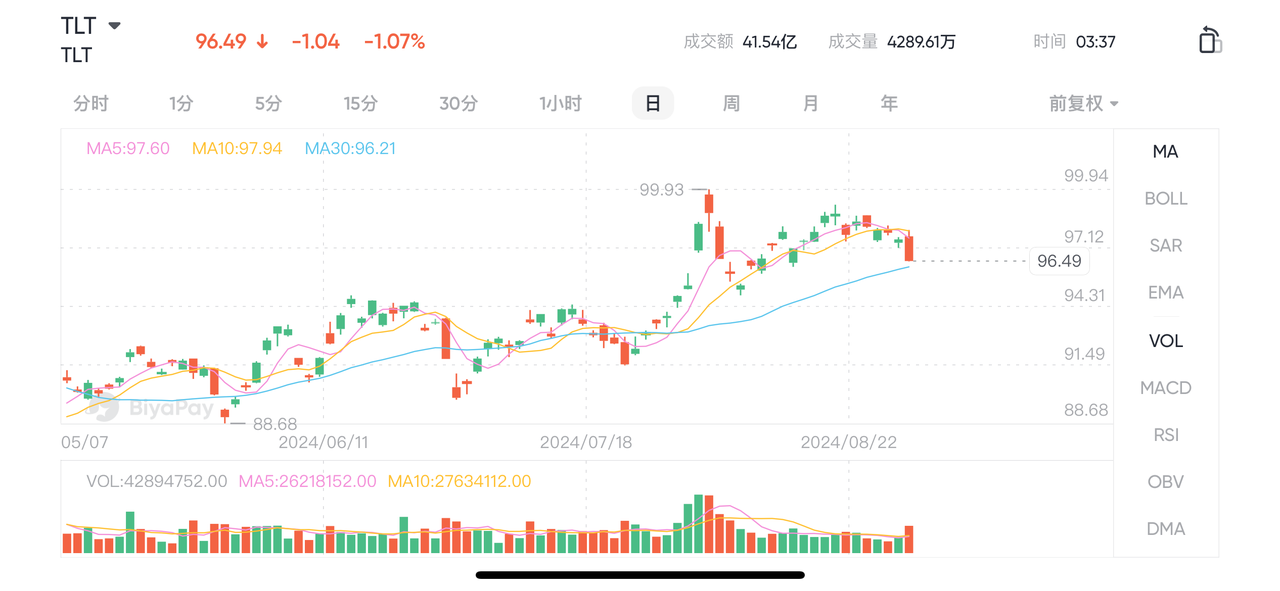
Next, how do you go about buying ETFs?
Actually, trading ETFs is very simple. You just need to choose a low-cost, stable, and secure online trading platform. Some well-known U.S. stock trading platforms offer low-cost trading services with excellent user experiences and research tools. Once you open an account, you can buy and sell ETFs just like trading stocks.
Here’s a recommendation: the multi-asset trading wallet BiyaPay. Just determine your goals, and you can use the platform to input stock codes to search and track them, then trade ETFs in real-time online when the time is right. The platform also supports digital currency (USDT, BTC, etc.) deposits and withdrawals of USD/HKD to a bank account, then you can transfer funds to other broker platforms for ETF trading.
By adopting a dollar-cost averaging strategy combined with the multi-asset trading wallet BiyaPay, investing a fixed amount regularly each month or week to buy ETFs, you can mitigate the impact of market fluctuations on investment costs and help achieve long-term, stable investments. Besides, it’s crucial to do your homework and understand the characteristics and risks of ETFs so that you can truly master this powerful investment tool!
In summary
ETFs are a powerful investment tool, especially suitable for those who don’t have the time to pick stocks and time the market. With the content above, I hope you can grasp the basic knowledge of ETFs, understand their advantages and risks, and learn how to use ETFs to build your investment portfolio.
Investing is a marathon, not a sprint. Today, we’re just getting started. Throughout the journey of investing, I’ll continue to accompany you as we move forward, learn, and grow together, eventually achieving our wealth goals and dreams!

























